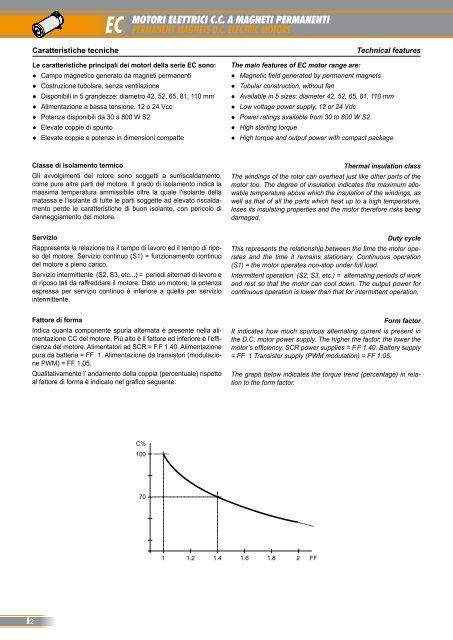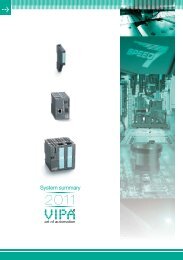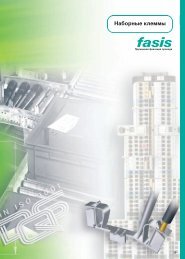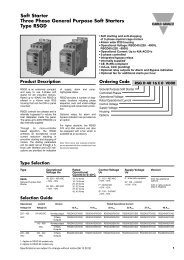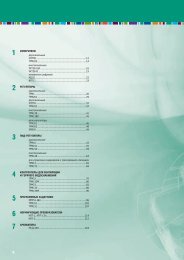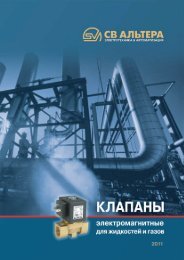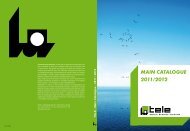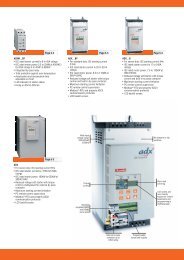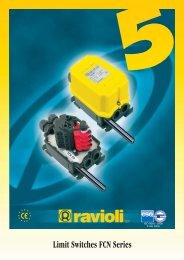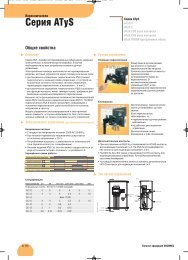MOTORI ELETTRICI C.C. a MaGnETI pERManEnTI pERManEnT ...
MOTORI ELETTRICI C.C. a MaGnETI pERManEnTI pERManEnT ...
MOTORI ELETTRICI C.C. a MaGnETI pERManEnTI pERManEnT ...
You also want an ePaper? Increase the reach of your titles
YUMPU automatically turns print PDFs into web optimized ePapers that Google loves.
EC<br />
<strong>MOTORI</strong> <strong>ELETTRICI</strong> C.C. a magneti permanenti<br />
Permanent magnets D.C. ELECTRIC MOTORS<br />
Caratteristiche tecniche<br />
Le caratteristiche principali dei motori della serie EC sono:<br />
●● Campo magnetico generato da magneti permanenti<br />
●● Costruzione tubolare, senza ventilazione<br />
●● Disponibili in 5 grandezze: diametro 42, 52, 65, 81, 110 mm<br />
●● Alimentazione a bassa tensione, 12 o 24 Vcc<br />
●● Potenze disponibili da 30 a 800 W S2<br />
●● Elevate coppie di spunto<br />
●● Elevate coppie e potenze in dimensioni compatte<br />
Technical features<br />
The main features of EC motor range are:<br />
●● Magnetic field generated by permanent magnets<br />
●● Tubular construction, without fan<br />
●● Available in 5 sizes: diameter 42, 52, 65, 81, 110 mm<br />
●● Low voltage power supply, 12 or 24 Vdc<br />
●● Power ratings available from 30 to 800 W S2<br />
●● High starting torque<br />
●● High torque and output power with compact package<br />
Classe di isolamento termico<br />
Gli avvolgimenti del rotore sono soggetti a surriscaldamento,<br />
come pure altre parti del motore. Il grado di isolamento indica la<br />
massima temperatura ammissibile oltre la quale l’isolante della<br />
matassa e l’isolante di tutte le parti soggette ad elevato riscaldamento<br />
perde le caratteristiche di buon isolante, con pericolo di<br />
danneggiamento del motore.<br />
Thermal insulation class<br />
The windings of the rotor can overheat just like other parts of the<br />
motor too. The degree of insulation indicates the maximum allowable<br />
temperature above which the insulation of the windings, as<br />
well as that of all the parts which heat up to a high temperature,<br />
loses its insulating properties and the motor therefore risks being<br />
damaged.<br />
Servizio<br />
Rappresenta la relazione tra il tempo di lavoro ed il tempo di riposo<br />
del motore. Servizio continuo (S1) = funzionamento continuo<br />
del motore a pieno carico.<br />
Servizio intermittente (S2, S3, etc...) = periodi alternati di lavoro e<br />
di riposo tali da raffreddare il motore. Dato un motore, la potenza<br />
espressa per servizio continuo è inferiore a quella per servizio<br />
intermittente.<br />
Duty cycle<br />
This represents the relationship between the time the motor operates<br />
and the time it remains stationary. Continuous operation<br />
(S1) = the motor operates non-stop under full load.<br />
Intermittent operation (S2, S3, etc.) = alternating periods of work<br />
and rest so that the motor can cool down. The output power for<br />
continuous operation is lower than that for intermittent operation.<br />
Fattore di forma<br />
Indica quanta componente spuria alternata è presente nella alimentazione<br />
CC del motore. Più alto è il fattore ed inferiore è l’efficienza<br />
del motore. Alimentatori ad SCR = F.F 1.40. Alimentazione<br />
pura da batteria = FF 1. Alimentazione da transistori (modulazione<br />
PWM) = FF 1.05.<br />
Qualitativamente l’ andamento della coppia (percentuale) rispetto<br />
al fattore di forma è indicato nel grafico seguente:<br />
Form factor<br />
It indicates how much spurious alternating current is present in<br />
the D.C. motor power supply. The higher the factor, the lower the<br />
motor’s efficiency. SCR power supplies = F.F 1.40. Battery supply<br />
= FF 1 Transistor supply (PWM modulation) = FF 1.05.<br />
The graph below indicates the torque trend (percentage) in relation<br />
to the form factor.<br />
C%<br />
100<br />
70<br />
1 1.2 1.4 1.6 1.8 2 FF<br />
I2


